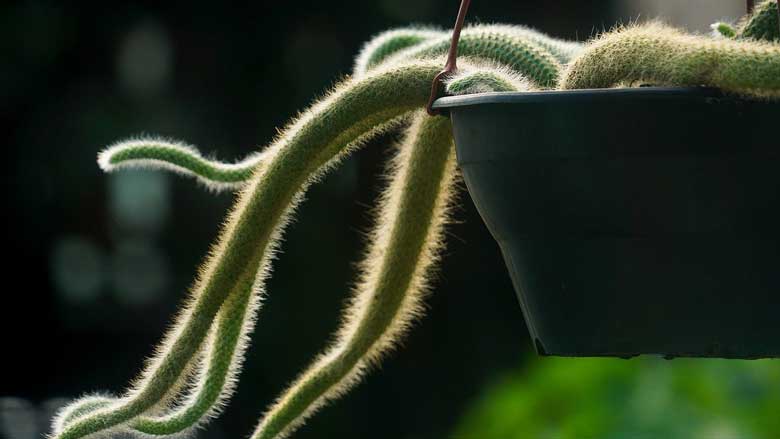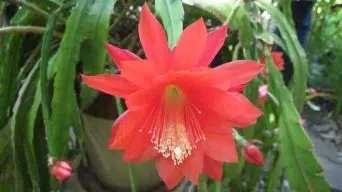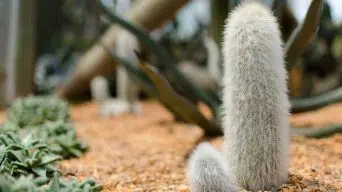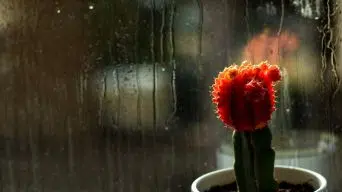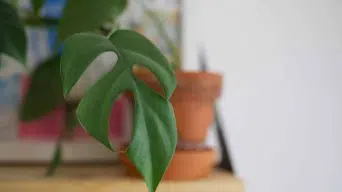Growing succulents is a hobby that is growing in popularity. Succulents are easy to grow and look beautiful when given proper care.
The Monkey Tail Cactus, or Cleistocactus colademononis, is an excellent plant for indoor and outdoor gardens.
This plant is both easy to care for and propagate.
Your plants will grow beautifully and reward you with beautiful flowers with the proper care.
This complete guide will give you the necessary knowledge to take care of your Monkey Tail Cactus plants properly.
Monkey Tail Cactus Overview
| Family: | Cactaceae |
| Genus: | Cleistocactus |
| Botanical Name: | Cleistocactus winteri |
| Synonyms: | Borzicactus colademononis, Cleistocactus colademononis, Hildewintera colademononis, and Winterocereus colademononis |
| Common Names: | Cola de Mono, Colademono, and Monkey tail cactus |
| Origin: | Santa Cruz, Bolivia |
| USDA Hardiness Zones: | 9a to 11b |
| Size: | 12 to 18 inches long (30 to 45 cm) |
| Sun Exposure: | Full sun to partial shade |
| Water Needs: | Water thoroughly but infrequently |
| Soil Type: | Well-draining soil |
| Temperature: | 65 to 80˚F (18 to 26˚C) during the day and 60˚F (15˚C) at night |
| Humidity Levels: | 40-50% |
The Monkey Tail Cactus, also known as Cleistocactus colademononis (syn. Hildewintera colademononis), is a cactus native to Bolivia in the Cactaceae family.
The Monkey Cactus is a white-spined, long-shaped cactus with a cascading form.
Every year, a single stem may reach almost a foot in length.
This cactus blooms with bright red flowers in the spring and early summer.
Monkey Tail Cactus are known for clinging to trees or tall structures, so they do well in hanging baskets, especially ones that can dangle freely.
Hanging baskets allow the cactus to dangle freely and grow straight down without obstruction.
The common name for this perennial succulent plant comes from its hairy appearance, which resembles a monkey’s tail.
The Cleistocactus colademononis cactus is also known as:
- Soft Monkey Tail Cactus
- Golden Rat Tail Cactus
- Golden Monkey Tail Cactus
- Monkey’s Tail Cactus
- Tarantula Cactus
- Rat Tail Cactus
How To Care for the Monkey Tail Cactus
Monkey Tail Cacti care is easy. Like other succulent plants, this plant requires only minimal care to thrive.
Once you have found a location that meets its needs, it will be happy there for many years.
The following is essential information about caring for your Monkey Tail Cactus plants.
Sun Exposure & Light Requirements
The Monkey Tail Cactus thrives in full sun to partial shade exposure.
It can even thrive in partial shade, but this plant should receive a maximum of 5 hours of direct sunlight daily.
If they receive too much shade, it will become weak and spindly over time.
Bright, indirect light is the best kind of light for this plant. It needs very bright but not direct sunlight to thrive.
Too much direct light can burn the plant, but too much shade weakens the cactus.
When grown indoors, west- or east-facing window exposure is best.
In the winter, the Monkey plants should face a south-facing window to receive as much light as possible.
Avoid intense midday sun exposure when grown outdoors, as the intense heat may sunburn the plant.
Watering Requirements
The Monkey Tail Cactus is a low-maintenance plant that thrives on minimal watering. The most common error among new cactus owners is overwatering, but fortunately, it’s an easy mistake to rectify.
Water your plant every one to two weeks, ensuring the soil is thoroughly soaked. After an hour or two, remove any excess water that accumulates in the pot.
For all cacti, it’s crucial to let the soil dry out between waterings and prevent the plant from sitting in water.
If your plant resides in a sunny location, consider more frequent watering. Similarly, if it has been outdoors during the summer, increased watering is necessary.
During winter, reduce the watering frequency to about once every two to three weeks for optimal cactus care.
Soil Requirements
The Monkey Tail Cactus plant needs light, well-drained, and porous soil.
It doesn’t like to grow in heavy clay soils or soils with low water absorption.
One way of dealing with such soil is using a cactus/succulent potting mix that can be bought from any garden center.
If you prefer using a homemade potting mix, I suggest using a mix of perlite, coarse sand, and potting soil in equal parts.
This mix gives a fine balance between water retention and drainage.
Temperature and Humidity Requirements
Monkey Tail Cactus needs a temperature between 15°C/59°F and 30°C/86°F.
So, if you live in a climate where the temperature usually goes below 10°C/50°F during winter, you must take extra measures to protect your plant from frost damage.
Monkey Tail plants are succulents from Central America, found in the canopy of moist forests.
However, it does not need to live in humid conditions to grow well. It will survive happily indoors under low humidity conditions.
Fertilizing
The Monkey Tail cactus does not need to be fertilized, but it is suggested to give it fertilizer every month during the growing season (spring and summer).
This is an excellent way to prevent nutrient deficiencies and promote flowering.
You can use a balanced liquid fertilizer diluted to half-strength during this time.
Be careful not to give it too much fertilizer, which can damage plants.
Do not feed your plants in the wintertime, as they will be dormant, and any nutrients you apply to them may cause harm to the plant’s roots.
Potting and Repotting
The Monkey Tail Cactus does not require much attention regarding potting and repotting. They need to be placed in a pot of the right size and the optimal potting mix.
These plants are commonly used in hanging baskets because they can be shaped into various forms.
When potted, the plant can grow quite large and should be kept in a pot that can accommodate the growth.
A minimum of 10 inches (25 cm) in width is needed, but if you place this plant in a hanging basket, it will have room to grow much larger.
A pot with drain holes in the bottom is important because it will help prevent root rot.
Cover the roots with a generous amount of potting soil when potting, filling the top half of the pot. Be careful not to press down on the plant; this will damage it.
Before you repot your cacti, remove any dead or dying roots first because this will help prevent root rot.
The best time to repot your cacti is in spring or early summer when its growth cycle begins again.
It is best to replant after the cactus flowers, but this will depend on where you live; you’ll need to ensure your plant has enough time to recover after replanting.
If you don’t want it to grow too large, put them in small pots. After a few years of growth, repot your plant into a larger pot than the previous one.
Pruning
The Monkey Tail Cactus does not require any hard pruning or cutting.
When the plants have grown too long, you can replant them in a bigger pot to prolong their life.
If your cacti are getting crowded and you need to separate them, cut through the stems with a sharp knife until they split apart.
When separating the stems, you can cut off any dead or dying stems to make them look nicer.
Just remove the dead parts as close to the base as possible, as rot can spread if you leave it attached to the rest of the plant.
Pests and Diseases
The Monkey Tail Cactus plant is generally resistant to pests and diseases.
However, they can be affected by some pests like spider mites, mealybugs, and scale insects.
Bacterial and fungal diseases can also affect some species of cacti. The most common of these is powdery mildew.
Spider Mites
Spider Mites are one of the most common pests that affect cacti.
They are sap-sucking creatures that live on the undersides of leaves and can easily spread to healthy parts of your plant, severely weakening it over time.
You can identify spider mites on your plant, as they gradually cause damage by yellowing the leaves and webbing on some species.
You can wash your plant of spider mites thoroughly with a soapy water solution.
Mealybugs
Mealybugs are little white bugs that suck juices from plants and cause damage to the plant’s stem, leaves, and flowers.
You can identify mealybugs on your plant by their cottony white mass and honeydew excrement on the leaves of your plants.
You can remove mealybugs on your cactus by dabbing with a cotton ball soaked in isopropyl alcohol or washing your plant with soap and water.
Scale Insects
Scale insects are clear, flattened bugs that feed on your plant’s juices.
They are immobile pests, so you won’t see them move around much.
You can identify scale insects by their shell-like appearance on the stems of your plants.
You can eliminate scale insects on your cactus by dabbing with a cotton ball soaked in isopropyl alcohol.
Powdery Mildew
Powdery mildew is a fungal disease that affects cacti.
You can identify it by the white powder covering the stems and leaves of your plant. It looks similar to other fungi that infect plants, but you can identify it by its powdery texture.
Powdery mildew is easily spread between cacti, so keep your plant isolated to prevent the infection from spreading further.
You can wash your plant of powdery mildew with soap and water or with a solution of baking soda and water.
Root Rot
Root rot is a common issue affecting various plant types, including cacti.
It is caused by the growth of harmful fungi in the soil, usually in conditions where the soil is consistently too wet.
Cacti are adapted to arid environments and have shallow root systems, making them susceptible to root rot if their soil remains excessively moist.
How to Care for the Monkey Tail Cactus in Winter
The Monkey Tail Cactus winter care should include temperatures at about 55-60° Fahrenheit, about 12° Celsius.
The temperature should be maintained between 50-65° Fahrenheit during the winter season. It can survive in colder climates but should be protected from frost and freezing.
When the temperatures fall below 55° Fahrenheit, bringing your succulent indoors is advisable.
The Monkey Tail Cactus is a desert cactus and can survive on little water and light. However, it won’t tolerate freezing temperatures, so you should keep the plant in a warm environment with sunlight exposure during winter.
In winter, you should reduce the water given to your plants. Watering once a month can be enough if they aren’t exposed to freezing temperatures.
You should also stop fertilizing cacti when winter comes around, as they will start to enter a dormant stage.
This will help prevent growth or sprouting during winter.
If you live in an area with mild winters, you can follow the same care routine as during spring, summer, and fall.
How To Propagate a Monkey Tail Cactus
The Monkey Tail Cactus is a unique species, and while it is not the most common cactus species, it is still relatively easy to care for.
The propagation process can be done by seed or stem cutting.
Stem Cuttings Propagation
To propagate your Monkey Tail Cactus by stem cutting:
- Select a healthy stem that is approximately five inches in length. The base should be one inch across to ensure proper rooting, but the larger, the better.
- Fill a small pot with cactus potting soil. Be sure the pot has good drainage to prevent root rot.
- Remove any spines on the lower half of your cutting, and gently push it into the soil so that only the tip is sticking out of the soil.
- Moisten, but do not saturate the soil, and place out of direct sunlight (no more than four hours per day) until your cutting has developed a root system.
- Once your plants develop new growth, they may be transplanted into a larger container with regular cactus soil.
Seed Propagation
To propagate your Monkey Tail Cactus by seed:
- Collect fresh, ripe seeds from a healthy plant. Use gloves to avoid the prickly hairs of the cactus getting stuck on your skin.
- Place collected seeds into a glass dish and leave them out overnight until the outer skin has dried.
- Once you are ready to remove the outer skin, do so by hand or with a wire mesh sieve.
- Fill small pots with cactus soil and sow the seeds thinly on top of the surface.
- Cover your seedlings and place them in indirect sunlight. Keep moist but not wet and allow to germinate (this can take several months, depending on how fresh your seeds are).
- Once your cacti are large enough to transplant, remove them from their original pots and plant them into a new pot with regular cactus mix.
Final Thoughts
Caring for succulents is pretty straightforward; however, certain growing conditions must be met to thrive.
Succulents need well-draining soil, proper sunlight exposure, and careful watering practices.
The Monkey Tail Cactus, with its unique appearance and relatively low maintenance requirements, is an excellent choice for succulent enthusiasts.

